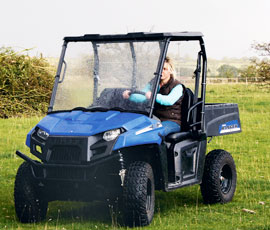Electric farm buggy lets you creep up on pests

A quick go with Polaris’s new £12,000 electric-powered farm buggy suggests that it could be a good substitute for a diesel-powered version. It’s great at sneaking up on farm pests too, says David Cousins.
Sit in any diesel farm buggy for any length of time and you soon begin to notice that the vibration from the engine is slowly but surely trying to encourage your fillings to drop out. It’s true that some machines are smoother than others, however it’s rare to be able to successfully sneak up on anything more alert than a sedated snail – let alone a bunch of flighty cattle or unsuspecting rabbits – without scaring them off.
But a couple of makers are now offering electric alternative to their usual petrochemically-powered fare. And Polaris was one of the first runners out of the traps with its hushed Ranger EV.
For those who doubt the ability of electric vehicles to do a proper job of work, the Polaris quickly dispels any misgivings. With a 567kg towing capacity, decent 454kg payload and substantial cargo box – it has everything that a fuel-powered posseses. Except that it’s quiet – so very quiet.
In fact it’s uncanny. Although the ignition is on, you’re not quite sure if anything’s going to happen when you put your foot on the throttle. Engage drive (through a slightly confusing series of buttons. You select forward or reverse then high/medium/max) and you’re away in no time – with the pick-up being swifter than you’d expect.
Whether you’re working in a barn or in the field, the quietness of the EV takes a bit of getting used to – especially for livestock. Take the tups we tested it with; they didn’t quite know what to make of it. They’re used to an old Land Rover and usually come running in case a smidgen of cake is to be had – so this silent shepherd took them by surprise. Moreover the horses in the field were a little spooked when the EV suddenly appeared next to them without making a noise.
But for pest control there’s nothing better and quieter than an electric vehicle – apart from sneaking up barefoot disguised as a small tree.
There are three selectable modes: high for road work and transport, low for towing and max for getting the longest operating time between charges.
Power is supplied by a 30hp 48v battery that, when fully charged, can in theory travel up to 50 miles. Charging couldn’t be simpler – simply take the plug out of the glove compartment and plug it into the mains.
Typical features like independent adjustable front and rear suspension and plenty of travel make it capable off road and, for longer trips it’s more than adequate. On-demand all wheel drive means that when the rear wheels start to slip all four wheels are engaged for extra traction. At other times, it automatically reverts back to 2wd.
FW Verdict
If we had had it for slightly longer, it would have been good to test the towing capacity over long distances to see how it affected the battery life. However, during the time we tested it for shepherding and lamping – this vehicle really impressed.
Likes
• Responsive and swift performance
• Capable off-road
• Silent
• Good battery life
Gripes
• Long charge time
• Complicated dash
• No notification to indicate when switched on
• Overly bright lights on dash at night
COMING SOON: A video of the Polaris Ranger EV in action

